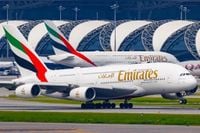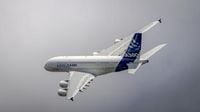On October 25, 2025, two major airlines—Emirates and Delta Air Lines—stood at pivotal crossroads in the evolution of their widebody fleets, each grappling with the realities of aging aircraft and shifting industry trends. For Emirates, the challenge is existential: the world’s largest operator of the Airbus A380 faces a future without its flagship superjumbo, as Airbus has ceased production and offered no direct successor. Meanwhile, Delta Air Lines bid farewell to its highest-capacity Airbus A350-900 configuration, marking the end of an era for a unique fleet acquired under unusual circumstances.
Emirates’ relationship with the Airbus A380 has always been a passionate one. According to djsaviation.net, the Dubai-based carrier operates over 100 A380s, making it by far the largest operator of the double-decker aircraft. The A380, with its immense capacity and luxurious features, is central to Emirates’ strategy for serving high-demand, long-haul markets. Yet, as of late October 2025, this very reliance has become a liability. The average age of Emirates’ A380 fleet has crept up to 10.8 years—still relatively young by some standards, but a sign of aging for an airline that has long prided itself on operating a youthful fleet.
The problem? Airbus ended A380 production after several cancellations, and—crucially—did not replace it with a new model. Instead, Airbus and rival Boeing have shifted their focus to more efficient twin-engine widebodies, leaving Emirates without a like-for-like replacement for its workhorse. There is no new superjumbo on the horizon. As djsaviation.net highlights, Emirates’ calls for an A380neo, a hypothetical next-generation version with new, fuel-efficient engines and other upgrades, have gone unanswered. The airline even proposed its own designs to Airbus, hoping to spur development, but to no avail.
With no direct successor available, Emirates is now forced to keep its A380s flying longer than originally planned. The airline has begun a major refurbishment program, updating the interiors of its A380 and Boeing 777 fleets to align with its incoming next-generation aircraft like the A350 and 777X. This move is both a stopgap and a strategic investment: it allows Emirates to maintain high service standards and extend the operational life of its flagship jets, even as they age.
But the long-term solution remains elusive. As djsaviation.net reports, Emirates has shifted its focus to advocating for larger, more efficient versions of existing widebodies. Two proposed models stand out: the Boeing 777-10 and the Airbus A350 Stretch (also known as the A350-2000), both designed to seat over 400 passengers. These aircraft, if ever launched, could help fill the gap left by the A380. Yet, for now, neither planemaker has committed to building them, leaving Emirates in limbo.
Without new ultra-high-capacity jets on the immediate horizon, Emirates is preparing for a future that may look very different from its past. The airline plans to keep its A380s in service into the 2040s, likely making it the last operator of the world’s largest passenger plane. There is no second-hand market for these giants, and no conversion to freighters is on the table. The airline’s unique affection for the A380—once a competitive advantage—now poses a serious strategic dilemma. As the superjumbo enters its twilight years, Emirates must balance nostalgia with pragmatism, investing in upgrades while preparing for an eventual transition to a new generation of aircraft.
Across the Atlantic, Delta Air Lines is dealing with a different, but related, fleet evolution. On October 25, 2025, Delta ended flights using its highest-capacity Airbus A350-900 configuration—a 339-seat layout unique to aircraft it acquired from South American carrier LATAM. The story behind these planes is itself a product of industry upheaval: in May 2020, LATAM filed for bankruptcy protection, a move hastened by the global pandemic and the resulting collapse in international travel. Looking to shed expensive assets, LATAM offloaded its relatively young A350-900s, which Delta snapped up opportunistically, much as it had done in the past with other aircraft types.
The 339-seat A350s, which entered Delta’s revenue service in June 2022, featured 30 business class seats (in a 2-2-2 layout), 63 extra legroom seats, and 246 main cabin seats. The configuration was high-density, designed for maximum capacity rather than maximum comfort—a compromise that soon became apparent. As reported by industry sources, the business class product was particularly lacking by modern standards, with seats that did not offer direct aisle access. This made the planes less competitive on premium long-haul routes, contributing to Delta’s decision to reconfigure them.
By October 25, 2025, only one aircraft—registration N569DZ, aged 9.7 years—remained in the 339-seat configuration. On that day, it operated its final passenger service in this layout, flying from Amsterdam to Atlanta, Delta’s fortress hub where it controls a staggering 79% of all flights. After this last hurrah, N569DZ was scheduled to fly to Singapore’s Paya Lebar for reconfiguration into a 275-seat, high-premium layout, which Delta plans to deploy on its longest international routes.
The retirement of the 339-seat A350 configuration marks the end of a brief, but notable, chapter in Delta’s fleet history. According to Cirium Diio data, these aircraft operated primarily international routes, with Atlanta accounting for 94% of all departures. The Atlanta-Lima route was especially prominent, responsible for 15% of the total flights operated by the high-density A350s. With their departure, Delta’s A350 fleet will consist only of 275-seat and 306-seat layouts, both offering enhanced comfort and premium features more in line with passenger expectations on long-haul journeys.
Delta’s decision to reconfigure its ex-LATAM A350s reflects broader trends in the airline industry. As carriers retire older, less efficient widebodies—such as the Boeing 777, which Delta phased out in recent years—they are increasingly focused on optimizing fleet commonality, passenger experience, and operational efficiency. The pandemic accelerated these shifts, forcing airlines to make tough choices about which aircraft to keep, which to upgrade, and which to retire.
Taken together, the stories of Emirates and Delta illustrate the challenges facing global airlines as they navigate a period of profound change. The era of the superjumbo, once seen as the future of long-haul travel, is drawing to a close, with no clear replacement in sight. Airlines must now balance the demands of capacity, efficiency, and passenger comfort in a market shaped by new realities—technological, economic, and environmental.
For Emirates, the challenge is to sustain its unique business model without the A380, while coaxing manufacturers to develop the next generation of high-capacity jets. For Delta, it’s about refining its fleet for flexibility and premium appeal, even as it says goodbye to the last of its highest-capacity A350s. Both airlines, in their own ways, are writing the next chapter in the story of global aviation—one marked by adaptation, innovation, and a touch of nostalgia for the giants of the skies.
As the sun sets on these iconic aircraft configurations, the industry’s gaze turns forward, wondering what shape the future of long-haul travel will take—and which airline will be bold enough to define it.

